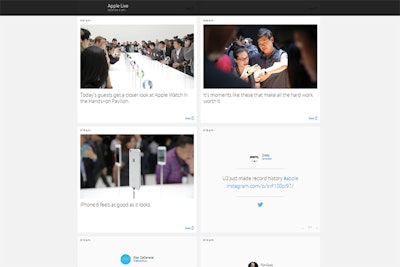
By now news has spread about the multiple technical glitches during the live stream of Apple’s announcement of the new iPhone 6 and Apple Watch on September 9. From the video feed that intermittently froze or restarted from the beginning to an audio feed of Mandarin Chinese translation playing in the background, the online experience left viewers frustrated and a bit shocked that, during what was arguably its biggest announcement of the year, the tech giant could fail so publicly. We asked several people with expertise in live online events to share their opinions on what went wrong and what planners can learn from Apple’s experience.
"When you think about doing a hybrid event, sometimes people tend to focus on the streaming video. How do we make sure the video streams to everybody’s devices? The truth of the matter is there are a lot of things happening all at once. The images, the slides, all of these little pieces. Apple decided they would do a cool interactive window that would be accompanied with the live stream. It was a little piece of Java script that showed the Twitter feed, but in order for it to show new tweets, it had to constantly refresh the entire page that surrounded the video stream. If you don’t architect that part in addition to whatever you are doing with your streaming, you are going to be in serious trouble. The second problem they had was the encoders they had on site were set up wrong. They were sending out a stream that had Chinese translation on top of it. There’s no way they would have had that problem if they tested it that morning. We cannot put our name on something if we don’t have adequate time to set up, to test, and to test again. We say get the locations that will be watching and get them to watch the test, because different parts of the world have issues with Internet and bandwidth. You have to have enough time to diagnose that. At the end of the day Apple didn’t provision and plan for the event properly. They threw a lot of things at it, they tried a lot of things, and they made a lot of assumptions. And this is what happened. Everything they had as far as the infrastructure was the right pieces, it just wasn’t set up right. It’s really totally unacceptable. This is not the technology that failed ... the people that implemented it [were] the ultimate failure. People think money solves everything. It doesn’t. It’s preparation and planning."
Donny Neufuss, account manager for event services, Sonic Foundry
"The real lesson is test out new features, test out the functionality, try to simulate the environment as best as possible of what you’ll be doing the day of the event. It’s harder for the event industry because maybe you don’t have access to the venue where you’ll be streaming from. So for something this crucial, and you are streaming to hundreds of thousands of people and it is vital to your organization, you better get a dress rehearsal in there. Second, ask what type of redundancy and recording is being done. Often when we stream an event, a lot of streaming companies do not do a local recording. It just streams to the cloud. And the audiovisual company may only be capturing and recording from one camera. You’re not getting the PowerPoint or any videos that are being shown. And that can be absolutely vital to that presentation. Apple obviously did this because what they sent out afterwards on demand was perfectly fine, so they did record locally."
Midori Connolly, founder, AVGirl Productions
"Streaming media is not rocket science anymore, but just being able to stream media is not what is needed. And Apple proved that. You need a work flow and an ability to present a presentation that everyone can see and understand and access on multiple devices, and ensure that it works. We battle this every day. Producers buy a laptop and an encoder and say they can do this, and next thing you know businesses like ourselves that are dedicated to this are competing with guys who are working out of their basements saying, 'I can do that too.' You are producing for the Web, which is a much smaller screen. Most of the camera shots of the speakers were shot super far away as if to show the whole stage. That works when you are watching on high-definition on a plasma screen, but when you are watching it on your phone you lose the emotion of what that person is saying. That’s something that a producer who works in TV doesn’t understand. Experts in this world of streaming media for corporate know our video window is so much smaller. And you have to keep your shot tighter and there are ways you have to produce your event that are slightly different than television or film. So you want to work with a partner that understands the medium. Corporate planners don’t have the luxury like a daily television show has. If you watch CNN nonstop all day, mistakes happen from time to time, but that’s okay because they are going out live all day long, every day. Corporate planners doing one of these or four of these a year don’t have that luxury. Everything needs to be perfect."
Matthew Ley, president, The Streaming Network
"We’re huge believers in the way they are starting to do this. It really validates the things we’ve been talking to our clients about for years about engaging remote viewers. So they posted tweets and photos and Instagram pics—all kinds of additional rich content beyond the stream—but that’s where the problem was. The page had hundreds of posts and each one had to load in addition to the video stream. Although we believe fervently in what Apple was trying to do, it wasn’t well engineered for a live event. Somebody bought the vision, but the company that executed it just didn’t have experience delivering streams like this. It’s all human error, 100 percent. There were multiple mistakes that stacked up on each other. These are the things you learn through pain. We’ve made some mistakes too, not quite as publicly, but that’s how you learn. Unfortunately these were pretty basic mistakes for the size of the expected audience. There were other things that were just super annoying to me and show Apple’s arrogance. They only chose to deliver through Safari—not Chrome, not Firefox—so that meant no Androids. To me, if you are trying to broaden your reach, don’t get super specific. A lot of streaming companies only deliver through Flash, which is a mistake also, because then Apple devices can’t stream. So making sure you are reaching all mobile devices is very important."
Aaron Booker, founder and C.E.O., Varvid
"The worldwide live stream without problems is like a Yeti: Everyone believes it exists but no one has seen it. There are millions of things that can go wrong, from technical problems to human error. I believe Apple can turn this failure into something that can enforce the brand. Because up until now everyone thought of Apple as something extraordinary. Now they can put a human face on the company. And Apple's lagging live stream was somehow a forgivable glitch. It happens even to the best of us. However, I was very disappointed by the fact that I was able to watch it only on Apple's homegrown Safari. It felt forced, as Safari is currently used only by 10.8 percent of desktop users, many people were simply turned away. It’s also really fascinating and sometimes hard to believe that Apple is still ignoring social media. They have a profile on Twitter, but they are completely inactive. And while they were expecting loads of people would be tweeting, they didn’t make any effort to introduce the hashtag. People therefore adopted several hashtags to be on the safe side, but it was simply confusing to follow several streams and inefficient to use the limited number of characters to include multiple hashtags."
Juraj Holub, social media and content marketing specialist, Sli.do
"The key is to understand the audience and have true redundancy on critical parts of the stream: transmission, encoding, and content delivery network. I can't imagine they were trying to save money or do the show on the cheap, so it is very baffling. Not that we have not had failures, but only where we could not get the budget for redundancy. They seemed to have problems everywhere from the site crashing, bad production, and live streaming. I feel bad for them because it’s just unbelievable that they could be so careless. There must have been something else contributing to their issues."
Russell Quy, executive producer, B Productions
"They are just such a powerful brand that this type of drop or letdown doesn’t really matter. An Apple fan boy isn’t going to not pre-order the iPhone 6 because the stream dropped. I can’t imagine it affects Apple in any way, shape, or form. I would dare to say this might even have been calculated and been very purposeful [to] cause a lot of buzz about the live stream in general."
Nick Caston, technology consultant



















